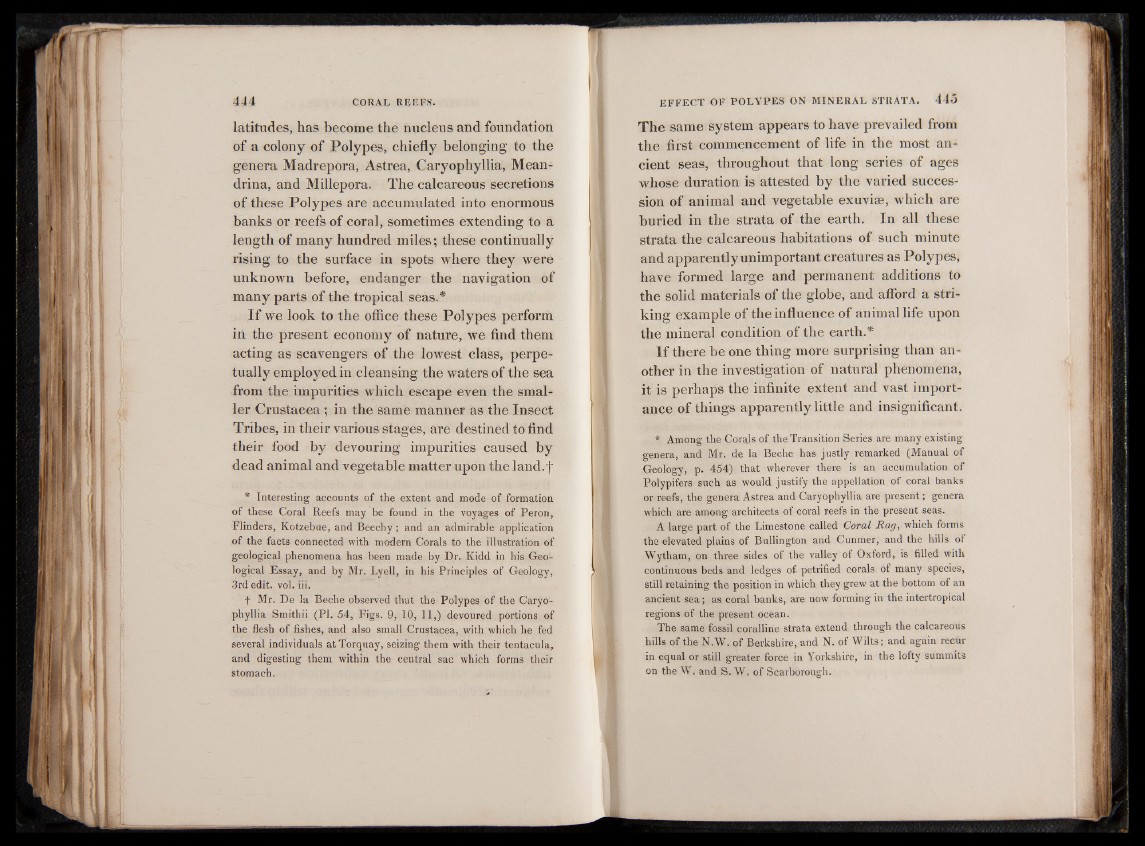
latitudes, has become the nucleus and foundation
of a colony of Polypes, chiefly belonging to the
genera Madrepora, Astrea, Caryophyllia, Mean-
drina, and Millepora. The calcareous secretions
of these Polypes are accumulated into enormous
banks or reefs of coral, sometimes extending to a
length of many hundred miles; these continually
rising to the surface in spots where they were
unknown before, endanger the navigation of
many parts of the tropical seas.*
I f we look to the office these Polypes perform
in the present economy of nature, we find them
acting as scavengers of the lowest class, perpetually
employed in cleansing the waters of the sea
from the impurities which escape even the smaller
Crustacea ; in the same manner as the Insect
Tribes, in their various stages, are destined to find
their food by devouring impurities caused by
dead animal and vegetable matter upon the land.'!'
* Interesting accounts of the extent and mode of formation
of these Coral Reefs may be found in the voyages of Peron,
Flinders, Kotzebue, and Beechy ; and an admirable application
of the facts connected with modern Corals to the illustration of
geological phenomena has been made by Dr. Kidd in his Geological
Essay, and by Mr. Lyell, in his Principles of Geology,
3rd edit. vol. iii.
f Mr. De la Beche observed that the Polypes of the Caryophyllia
Smithii (PI. 54, Figs. 9, 10, 11,) devoured portions of
the flesh of fishes, and also small Crustacea, with which he fed
several individuals at Torquay, seizing them with their tentacula,
and digesting them within the central sac which forms their
stomach.
The same system appears to have prevailed from
the first commencement of life in the most ancient
seas, throughout that long series of ages
whose duration is attested by the varied succession
of animal and vegetable exuviae, which are
buried in the strata of the earth. In all these
strata the calcareous habitations of such minute
and apparently unimportant creatures as Polypes,
have formed large and permanent additions to
the solid materials of the globe, and afford a striking
example of the influence of animal life upon
the mineral condition of the earth.*
I f there be one thing more surprising than another
in the investigation of natural phenomena,
it is perhaps the infinite extent and vast importance
of things apparently little and insignificant.
* Among the Corals of the Transition Series are many existing
genera, and Mr. de la Beche has justly remarked (Manual of
Geology, p. 454) that wherever there is an accumulation of
Polypifers such as would justify the appellation of coral banks
or reefs, the genera Astrea and Caryophyllia are present; genera
which are among architects of coral reefs in the present seas.
A large part of the Limestone called Coral Rag, which forms
the elevated plains of Bullington and Cunmer, and the hills of
Wytham, on three sides of the valley of Oxford, is filled with
continuous beds and ledges of petrified corals of many species,
still retaining the position in which they grew at the bottom of an
ancient sea; as coral banks, are now forming in the intertropical
regions of the present ocean.
The same fossil coralline strata extend through the calcareous
hills of the N.W. of Berkshire, and N. of Wilts; and again recur
in equal or still greater force in Yorkshire, in the lofty summits
on the W. and S. W. of Scarborough.